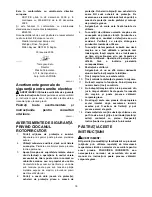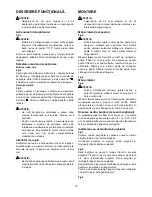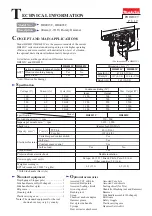
5
Hammering only
Fig.3
For chipping, scaling or demolition operations, depress
the lock button and rotate the change lever so that the
pointer points to the
symbol. Use a bull point, cold
chisel, scaling chisel, etc.
CAUTION:
•
Do not rotate the change lever when the tool is
running under load. The tool will be damaged.
•
To avoid rapid wear on the mode change
mechanism, be sure that the change lever is
always positively located in one of the two or three
action mode positions.
Torque limiter
The torque limiter will actuate when a certain torque
level is reached. The motor will disengage from the
output shaft. When this happens, the bit will stop turning.
CAUTION:
•
As soon as the torque limiter actuates, switch off
the tool immediately. This will help prevent
premature wear of the tool.
ASSEMBLY
CAUTION:
•
Always be sure that the tool is switched off and
unplugged before carrying out any work on the
tool.
Side handle (accessory)
Fig.4
CAUTION:
•
Use the side handle only when chipping, scaling or
demolishing. Do not use it when drilling in concrete,
masonry, etc. The tool cannot be held properly with
this side handle when drilling.
The side handle can be swung 360° on the vertical and
secured at any desired position. It also secures at eight
different positions back and forth on the horizontal. Just
loosen the clamp nut to swing the side handle to a
desired position. Then tighten the clamp nut securely.
Fig.5
Side grip
Fig.6
CAUTION:
•
Always use the side grip to ensure operating safety
when drilling in concrete, masonry, etc.
The side grip swings around to either side, allowing easy
handling of the tool in any position. Loosen the side grip
by turning it counterclockwise, swing it to the desired
position and then tighten it by turning clockwise.
Bit grease (optional accessory)
Coat the bit shank head beforehand with a small amount
of bit grease (about 0.5 -1 g; 0.02 - 0.04 oz.). This chuck
lubrication assures smooth action and longer service
life.
Installing or removing the bit
Fig.7
Clean the bit shank and apply bit grease before installing
the bit.
Insert the bit into the tool. Turn the bit and push it in until
it engages.
Fig.8
If the bit cannot be pushed in, remove the bit. Pull the
chuck cover down a couple of times. Then insert the bit
again. Turn the bit and push it in until it engages.
After installing, always make sure that the bit is securely
held in place by trying to pull it out.
To remove the bit, pull the chuck cover down all the way
and pull the bit out.
Fig.9
Bit angle (when chipping, scaling or
demolishing)
Fig.10
The bit can be secured at 12 different angles. To change
the bit angle, depress the lock button and rotate the
change lever so that the pointer points to the
symbol.
Turn the bit to the desired angle.
Depress the lock button and rotate the change lever so
that the pointer points to the
symbol. Then make sure
that the bit is securely held in place by turning it slightly.
Fig.11
Depth gauge
Fig.12
The depth gauge is convenient for drilling holes of
uniform depth. Insert the depth gauge into the hole in the
grip base. Adjust the depth gauge to the desired depth
and then tighten the clamp screw to secure the depth
gauge.
The depth gauge is convenient for drilling holes of
uniform depth. Loosen the clamp screw and adjust the
depth gauge to the desired depth. After adjusting,
tighten the clamp screw firmly.
NOTE:
•
The depth gauge cannot be used at the position
where the depth gauge strikes against the tool
body.
•
The depth gauge cannot be used at the position
where the depth gauge strikes against the gear
housing/motor housing.






































